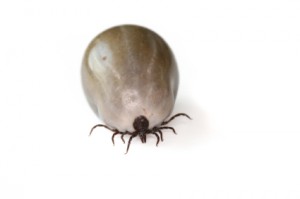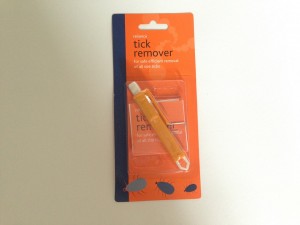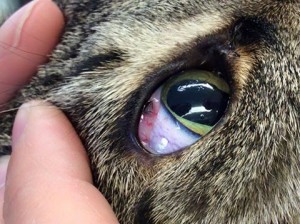Ticks come in lots of different colours and sizes; from grey, pink, red, brown and black, and right through from the size of a pin-head to a big fat juicy rice-crispy. They are carried on things like sheep and deer and drop off into the grass and undergrowth so that when an animal passes through, they grab onto it and thus have a new host. Dogs most often get them on their heads or necks because of they way they like to shove their faces into all sorts of places to sniff and explore, but also because the ticks like to latch on to parts of the body with a good blood supply near to the surface that’s easy to get to.
The tick starts off small, with skinny little black legs and 2 pincer-type mouthparts at the front, and a round abdominal sac at the back. They burrow their mouthparts into their host’s skin, lock on and then suck the blood straight out.
But how do they do that? Do they screw themselves in clockwise? Anti-clockwise? Straight down???? Well in actual fact, their “style” is more likened to the breast stroke. Click on the link to see a video and brilliant demonstration of just how the tick burrows into the skin.
http://www.smithsonianmag.com/science-nature/watch-a-tick-burrowing-into-skin-in-microscopic-detail-6649718/?no-ist
The abdominal sac then fills up with blood and swells to the size of a raisin.
They carry all sorts of nasty infections (including Lyme Disease) which they can pass on to the dog (and to you if you are not careful when you are dealing with them) so its really important to remove them as quickly and carefully as you can, and this is how you should do it.
First things first – get your gloves on. The infected blood and “juice” in a tick is dangerous stuff and you don’t want to risk getting it on yourself as you try to help your dog. Even the tiniest cut or injury to your fingers gives an excellent entry route for the contaminated tick blood to enter YOUR body too.
There are lots of old wives tales written and passed on about how best to get a tick off and although a lot of them will work, they do have a lot of risks associated with them, so first how NOT do it.
Do Not Squeeze the tick between your thumb and finger –
This will just inject the poisonous infected blood into your dog
Do Not Burn them off with a cigarette or match head –
The tick will regurgitate the poisonous infected blood into your dog as it tries to get away from the heat of the cigarette or match (the same is true of using alcohol or liquid soap).
Do Not Cover the tick in Vaseline –
Although this WILL suffocate the tick eventually, the tick will die potentially leaving his head buried in your dog.
Do Not Throw the tick into the toilet to dispose of it –
Ticks are fantastic little swimmers and will merely live to bite another day
Do Not Throw the tick onto the fire –
The tick will “pop” as the contents of its abdomen heats up and the noxious vapours will be released into the air and is dangerous if breathed in (particularly by young children and pregnant ladies)
Do Not Pull the tick’s body off the dog abruptly –
If the head is left in the dog it may become infected and cause an abscess
Removing ticks – what you SHOULD do:
Do Put on your gloves
Do Invest in a “tick-picker” which is a special tool just for the job. There are several versions of this instrument but the main two have either a loop at the end to hook around the tick’s body or a ‘V’ shape at the end to wedge under the abdomen. This is the one we stock, and it comes with sterile cleansing wipes and full instructions too
Either tool is fine but if you don’t have one at all, provided you have your gloves on, you can use your nails to grip the tick, as close as possible to the dog’s skin, and then firmly, but not too tightly, grasp the tick by the body and either twist or pull straight out in a constant movement, keeping the pressure on firmly but not “with a jerk”. The tick will put up quite a bit of resistance and then will suddenly let go (often with a bit of a “snap” kind of noise and feeling).
Do check that the tick’s head has not been left behind in the dog’s skin. If you are unsure, run your finger across the front end of the tick. If the head is there, it will feel like a hard grainy bit at the front which is the tick’s mouth parts. If it feels soft, then likely you have left the head in the dog’s skin. If it has, keep an eye on it as usually the head will be ejected as a “foreign body” by the dog’s skin on its own within a couple of days anyway.
Do clean the wound site with sterile wipes or soap and water.
Do dispose by killing it in some rubbing alcohol,putting it in a jar and keeping it for two or three days. If during this time your dog displays any behavioural changes or the wound appears infected, please take the dog AND THE TICK to the vet to beck checked for infection. It is easier to test a tick for Lymes Disease than the dog himself so having the critter with you to present to the vet is the best idea.
If you do not want to keep the tick, then please kill it by crushing in toilet tissue then place it in an outside bin.
For the most part, that will be that and a veterinary appointment is not usually necessary unless:
* The head is still in the dog’s skin after a couple of days.
* The area looks red and/or inflamed after a couple of days.
* The dog shows signs of changes in behaviour or discomfort.
* The tick is in the ear canal or very close to the eye lid, in which case you should not try to remove it yourself, but seek veterinary help.
As always, prevention is better than the cure. There are lots of pharmacological preparations you can use to try to prevent ticks with your dogs. Some of these drugs can be a little harsh or even contraindicated with some dogs so always check with your vet before starting on a new treatment regime, just to make sure he is happy with your choice of therapy (particularly if your dog is a herding breed as some have more problems than others – dogs with the MDR1 genetic fault in particular can struggle with pesticides so please do check first.)
I usually use grapefruit essential oil – a few drops in some almond oil – sprayed on to a mit and then wiped on to my dog’s coats weekly in “tick season” paying close attention to the head, ears and neck – as the ticks really don’t like either the citrus smell or that of the almond and this seems to do the job for us with a short-coated breed. Here’s a good article if you are looking for a more natural solution to try : https://www.dogsnaturallymagazine.com/natural-solutions-tick-season/
Below is an article posted in the telegraph prompted by the arrival of the “Brown Dog Tick” into the UK from abroad. This tick carries bacteria that can be fatal to dogs.
http://www.telegraph.co.uk/news/health/pets-health/11582064/Dog-owners-warned-of-risks-to-pets-of-disease-carrying-ticks.html





